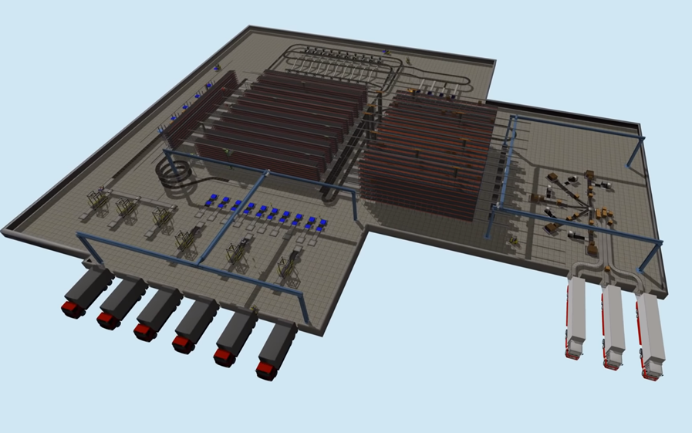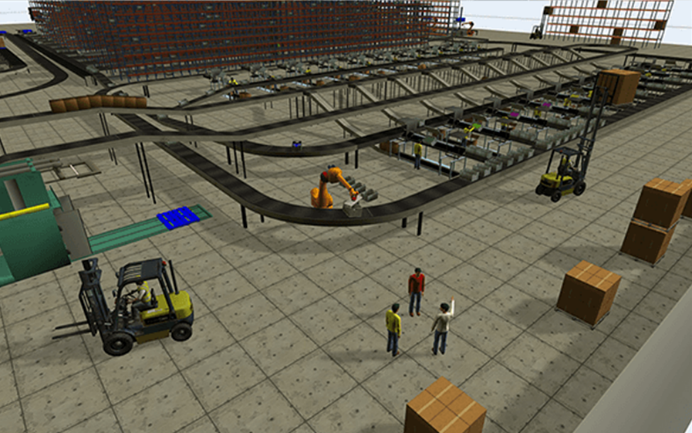Software
The Department of Enterprise Management and Economics has the following software for teaching, training, projects and research activities:
FlexSim
 FlexSim software from the US enterprise FlexSim Software Products, Inc. is one of today's most popular simulation tools. With its
help, it is easier to create digital models of business processes and systems and then performs the simulation and optimization.
Unlike other similar tools, FlexSim is universally used in many different areas - in manufacturing (mechanical engineering,
food industry, …), logistics, mining, but also in ICT, healthcare or public services. FlexSim can be used for example in
capacity planning of enterprise resources, identifying and eliminating bottlenecks, designing innovative changes, shortening
production times, verification of what-if scenarios or, for example, designing new systems.
FlexSim software from the US enterprise FlexSim Software Products, Inc. is one of today's most popular simulation tools. With its
help, it is easier to create digital models of business processes and systems and then performs the simulation and optimization.
Unlike other similar tools, FlexSim is universally used in many different areas - in manufacturing (mechanical engineering,
food industry, …), logistics, mining, but also in ICT, healthcare or public services. FlexSim can be used for example in
capacity planning of enterprise resources, identifying and eliminating bottlenecks, designing innovative changes, shortening
production times, verification of what-if scenarios or, for example, designing new systems.
The software goes significantly across current trends. It brings simulation in a realistic 3D graphical environment, a user-friendly interface and especially versatility and ease of use. The user has at his disposal a relatively large library of objects (machines, automatic forklift, forklift, robot, crane, warehouse racks,…) and additional tools/modules e.g. for creation of process logic (this reduces the need for programming), conducting experiments, optimizing or for creating statistical reports. Given the current complexity of business systems and processes and the volatility of the business environment, FlexSim brings the flexibility and speed needed to make business decisions of today.
The software was funded through the InterMarium Foundation.
Demonstration of the model for warehouse simulation and for service simulation using FlexSim software.
Source: FlexSim Software Products, Inc
Microsoft Power BI a Excel Power Query
 Microsoft Power BI and Excel Power Query are tools that fall into the Business Intelligence (BI) category. These tools are
used to collect, edit, model and visualize data and create dashboards and reports. The purpose of their use is to transform
raw data into information and then present it in the form of knowledge that is meaningful for business purposes. They help
in making decisions on important areas such as cost, revenue, production, quality, speed, etc. The target users are entrepreneurs,
managers or regular workers. In today's digitalized environment, knowledge and experience in using BI tools brings a great
advantage not only for corporate practice.
Microsoft Power BI and Excel Power Query are tools that fall into the Business Intelligence (BI) category. These tools are
used to collect, edit, model and visualize data and create dashboards and reports. The purpose of their use is to transform
raw data into information and then present it in the form of knowledge that is meaningful for business purposes. They help
in making decisions on important areas such as cost, revenue, production, quality, speed, etc. The target users are entrepreneurs,
managers or regular workers. In today's digitalized environment, knowledge and experience in using BI tools brings a great
advantage not only for corporate practice.

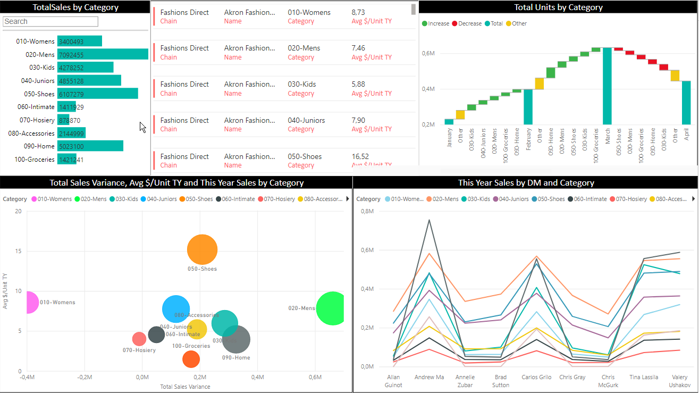

Business Navigation Game
![[pracoviste/12138/Inekon.png]](https://fs.cvut.cz/content/images/pracoviste/12138/Inekon.png) Studying through games at university? Why not! It’s been proven to work. Not only do students enjoy those classes more,
but they also better prepare them for practice. This is all thanks to the BNS−LUDUS integrated solution, which merges into
a single functional unit the BNS management information system used in hundreds of firms in the Czech Republic and abroad
and the LUDUS simulation software installed in hundreds of universities all over the world, including the Czech Republic.
This unique solution from the enterprise INEKON SYSTEMS allows a simulation game to be used in lessons, giving students the chance to actually
see how their management work will look in planning and controlling and how they fare in the competitive environment. BNS−LUDUS
supports tactical and strategic planning using the Balanced Scorecard methodology.
Studying through games at university? Why not! It’s been proven to work. Not only do students enjoy those classes more,
but they also better prepare them for practice. This is all thanks to the BNS−LUDUS integrated solution, which merges into
a single functional unit the BNS management information system used in hundreds of firms in the Czech Republic and abroad
and the LUDUS simulation software installed in hundreds of universities all over the world, including the Czech Republic.
This unique solution from the enterprise INEKON SYSTEMS allows a simulation game to be used in lessons, giving students the chance to actually
see how their management work will look in planning and controlling and how they fare in the competitive environment. BNS−LUDUS
supports tactical and strategic planning using the Balanced Scorecard methodology.
Simplified principle of Business Navigation Game: Students create teams of 3 to 8 students, Students create teams of 3 to 8 students that compete with each other with two or three products in up to four markets at the same time. In BNS – Strategic Maps the players propose a strategy within the bounds of their competence within the enterprise. As soon as the strategy has been approved, it is transformed into a business plan corresponding to the length of the game (up to 12 periods/quarters). This plan is prepared to span the whole of the functional areas – sales performance, total cost ratio and profitability, financial performance and resources and potentials. The finished plan must then again be approved by the team representing the company management. Then, together with the plans of the other student groups, it is automatically loaded into a market simulation (LUDUS). The players of the “Business Navigation Game” then immediately receive information about how their plan was received by the market as well as source data for another forecast and another decision, which they have to implement in the following round.
![[pracoviste/12138/Inekon01.png]](https://fs.cvut.cz/content/images/pracoviste/12138/Inekon01.png)
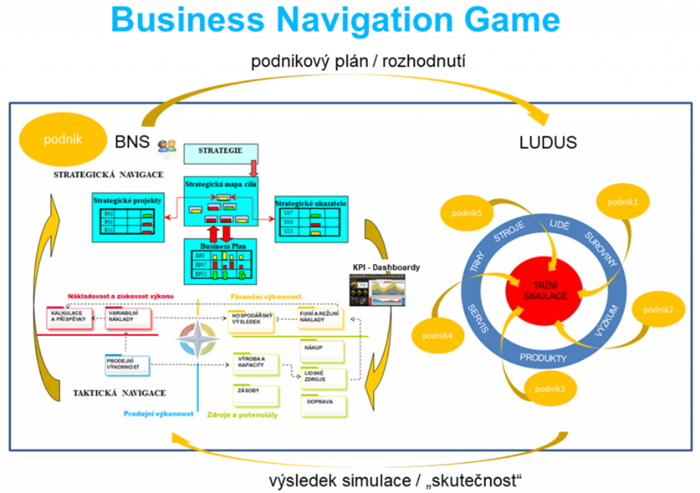
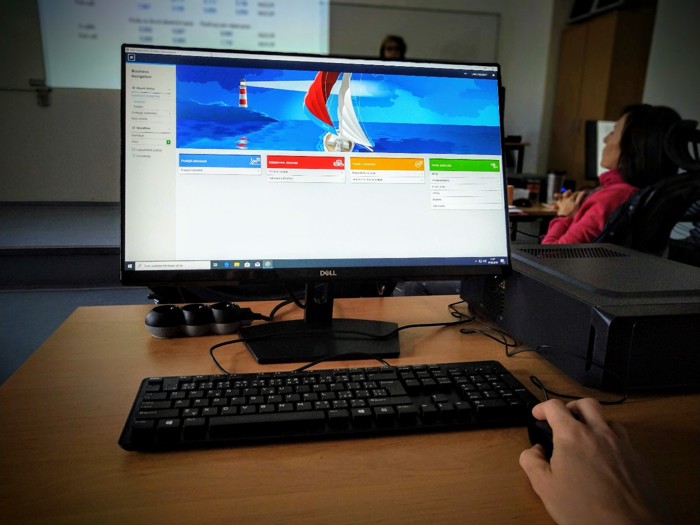
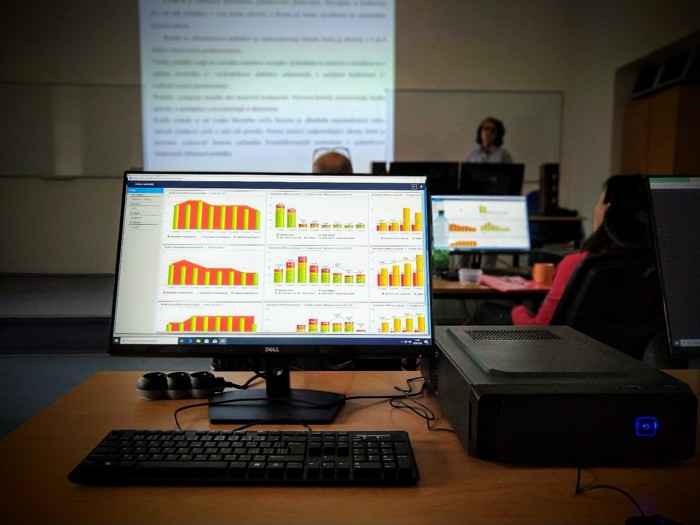
Albertina
 Albertina is an information database on the financial and non-financial situation of Czech business subjects and contact information.
The database is provided by BISNODE ČESKÁ REPUBLIKA, A.S.
Albertina is an information database on the financial and non-financial situation of Czech business subjects and contact information.
The database is provided by BISNODE ČESKÁ REPUBLIKA, A.S.
MS Project
MS Project is Microsoft's world-renowned software that makes planning, managing, communicating, and predicting business project
changes easier and more efficient.
Computer models in MS Excel
The Department of Enterprise Management and Economics is the author of a number of management tools created on the MS Excel
platform. These models, created using advanced MS Excel features, are used both in teaching and in enterprise applications
where they can function as either a full-fledged information system or as a functional prototype to create massive IS on specialized
platforms.
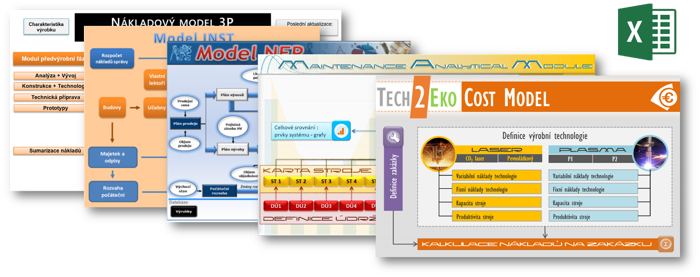
To illustrate, we present several reference models:
- Model NFP: The NFP model is a useful SW tool facilitating the process of creating an annual business plan and illustrating the interconnection of non-financial (number of units sold, material consumption, maturity of invoices, etc.) and financial variables (profit, cash-flow, etc.) in a corporate plan.
- Cost model 3P: Model for calculation of engineering order costs in pre-production, production and post-production phases. The model applies the Activity Based Costing concept, the hourly cost method and the calculation using the payment contribution.
- Model MAM (Maintenance Analytical Module): The MAM model has been designed as a decision support model that builds a specialized Computerized Maintenance Management System (CMMS) for complex analysis of the maintenance system. Its main mission is to provide maintenance managers with the information they need to select the appropriate maintenance strategy for a defined machine system in the enterprise so that maintenance resources (both human and financial) are used and allocated efficiently.
- Model Tech2Eko: The aim of the model is to characterize in detail the effect of the change of technical solution on economic characteristics (especially costs) for a defined model order. The model compares two progressive cutting technologies using laser and plasma. The model closely monitors the influence of individual parameters on the final costs of the processed order.
- Shyman Cost Model: The model was developed as part of the SHYMAN research project, which aims to develop commercially competitive, high-volume, continuous nanoparticle technology. SHYMAN Cost Model allows you to calculate costs for individual orders and can also be used for enterprise-wide planning and economic management.
SimaPro 8 Analyst
 SimaPro is one of the two most widely used LCA analysis software - Life Cycle Assessment. LCA is a method that allows a comprehensive
assessment of the environmental aspects of a product's life cycle. It is an approach that takes into account all phases of
the life cycle from raw material acquisition to final disposal of the waste into the ground. Thus, LCA is the only tool that
can be used to identify lifecycle improvement options for a product under assessment, as it identifies the most environmentally
relevant phases, ie, with the highest consumption of raw materials and energy, highest emissions to water, soil, air and the
largest solid waste production across the entire product system. SimaPro allows you to perform these comprehensive analyses
by linking to extensive environmental impact databases (Ecoinvent, USLCI,…).
SimaPro is one of the two most widely used LCA analysis software - Life Cycle Assessment. LCA is a method that allows a comprehensive
assessment of the environmental aspects of a product's life cycle. It is an approach that takes into account all phases of
the life cycle from raw material acquisition to final disposal of the waste into the ground. Thus, LCA is the only tool that
can be used to identify lifecycle improvement options for a product under assessment, as it identifies the most environmentally
relevant phases, ie, with the highest consumption of raw materials and energy, highest emissions to water, soil, air and the
largest solid waste production across the entire product system. SimaPro allows you to perform these comprehensive analyses
by linking to extensive environmental impact databases (Ecoinvent, USLCI,…).
In addition, it allows:
- Easy modelling of different product variants
- Tracking a wide range of impact categories (Cumulative Energy Demand, Carbon Footprint, Eco Indicator, EPD,…)
- Performing sensitivity analyses and more.
Tecnomatix Plant Simulation
![]()
 Tecnomatix Plant Simulation (Siemens PLM Software) is a tool for discrete event simulation. With its help, it is possible
to create digital models of production and logistics processes and systems and to simulate and optimize them. With Plant Simulation,
we can carefully check every important decision based on extensive analysis, statistics and graphs. We are able to verify
what-if scenarios without disrupting existing manufacturing systems. We can verify the effects of plans to purchase production
equipment (machines, handling equipment, etc.) before they are purchased to prevent inefficient investment. We can perform
capacity balancing, optimize production system performance, design entirely new production systems, and so on. Today, when
business is aggravated by globalization and environmental instability, this tool becomes an important means of making the
right decisions and success. Regardless of whether we want to minimize costs, reduce production lead times, or maximize production,
for example.
Tecnomatix Plant Simulation (Siemens PLM Software) is a tool for discrete event simulation. With its help, it is possible
to create digital models of production and logistics processes and systems and to simulate and optimize them. With Plant Simulation,
we can carefully check every important decision based on extensive analysis, statistics and graphs. We are able to verify
what-if scenarios without disrupting existing manufacturing systems. We can verify the effects of plans to purchase production
equipment (machines, handling equipment, etc.) before they are purchased to prevent inefficient investment. We can perform
capacity balancing, optimize production system performance, design entirely new production systems, and so on. Today, when
business is aggravated by globalization and environmental instability, this tool becomes an important means of making the
right decisions and success. Regardless of whether we want to minimize costs, reduce production lead times, or maximize production,
for example.
Illustration of rear axle assembly line simulation at Mercedes-Benz using Tecnomatix Plant Simulation, source: http://www.plm.automation.siemens.com
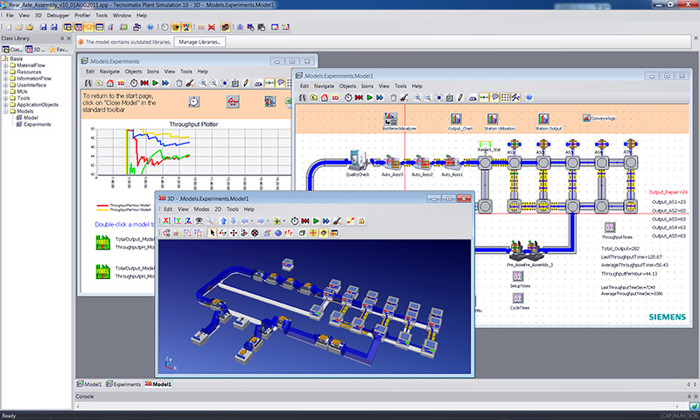
![[design/2014/cvut-logo-en-blue.png]](https://fs.cvut.cz/content/images/design/2014/cvut-logo-en-blue.png)
![[design/2014/cvut-logo-print.jpg]](https://fs.cvut.cz/content/images/design/2014/cvut-logo-print.jpg)
